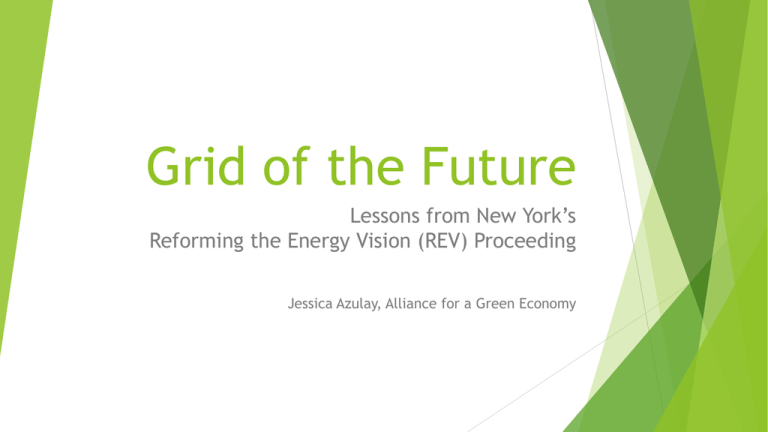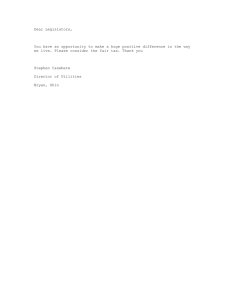Grid of the Future Lessons from New York’s
advertisement

Grid of the Future Lessons from New York’s Reforming the Energy Vision (REV) Proceeding Jessica Azulay, Alliance for a Green Economy Today’s Electricity System Centralized Generation $ $ Distribution Utility $ Consumers/ Ratepayers A System in Transition (Peak demand growing while demand is relatively flat in NY.) $ Aging & expensive Renewables $ $ Aging & expensive $$ Efficiency & Distributed Generation Transition to Distributed Energy Resources $ $$ $ $ $ Distributed Energy Resources - Efficiency - Small-scale renewables - Other distributed resources (like generators, including diesel and gas generators) - Storage - Micogrids - Demand response $$ $ Enabling and Encouraging Decentralization New roles for consumers Increased adoption of energy efficiency Increased adoption of distributed energy Change when electricity is used to reduce peak demand and to respond to variations in renewable energy production New system needs Inform and engage consumers as active participants System planning to avoid costs Aggregate and predict many small actions New prices based on system and social costs and benefits New infrastructure (physical and technological) Key Questions What will utilities be paid for? Who will be responsible for planning? What about consumer protections? Who will own the distributed energy resources? In New York, there is a battle for ownership and control over the system and the resources: Investor owned utilities vs Third party for-profit companies vs Community/local/public advocates Distributed System Platform (DSP) An institution to carry out many of the functions of the distributed energy resources market. - System planning - Predicting and bundling reductions in demand from the bulk power system - Promoting energy efficiency and distributed generation - Connecting distributed resources to the grid - Billing - Customer service - Supervisory control - Data acquisition (Control over the DSP was a major battleground in NY. PSC overruled public concern.) Grid of the Future Basic Elements (As envisioned in New York) • Create new markets for distributed energy • Create new institutions like the DSP • Develop new pricing models and new rate structures, such as time of use pricing and incorporation of externalities • Phase out subsidies in favor of “market animation” (Subsidies are another major battleground issue.) • Develop incentives for utility companies and decide their new role in the new energy system. Some Emerging Details in NY… Utilities will fill the role of DSP and will be paid by ratepayers to develop and run the market as well as to create an online portal for customers to shop for distributed energy resources Utilities will also be rewarded for meeting various public policy goals: reducing peak demand, improving energy efficiency, providing better affordability, and accelerating the interconnection or renewables to the grid. Utilities, in most cases, will not own distributed energy resources, but this does not mean that those resources will be owned by local communities or local individuals. They are likely to be owned and controlled by other private, for-profit corporations. Distributed energy resources be valued for their contributions to grid efficiency, reducing peak, and displacing carbon emissions. They will not necessarily be valued for their contributions to public health, the local economy or other social and environmental benefits. Opportunities for Local Ownership and Control Onsite Efficiency & Renewables (A new online portal, new DSP, and new rates might make distributed energy resources easier and more attractive for customers. At the same time, REV might create increased inequity of access because of its focus on markets mechanisms. What about the role of subsidies and regulation?) Community Choice Aggregation (Under consideration) Shared Renewables (Approved, now considering low-income access) Clean Energy Fund and Large Scale Renewables Track (Under consideration) Concerns and Challenges Will distributed energy create distributed (more equitable) ownership of energy assets? The focus on markets as the mechanism of change could create and reinforce inequality of access. The phase out of subsidies in favor of an unproven approach may create backsliding on progress. Should utilities retain a large amount of control over planning implementation. They are not accountable to the public. If not utilities, who? What consumer protections will be in place and how will they be enforced? Will the new utility rates be affordable? Thank you! Contact Jessica Azulay: jessica@agreenewyork.org

